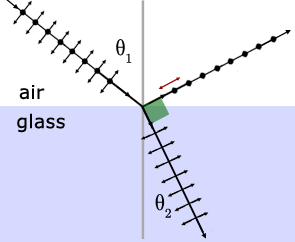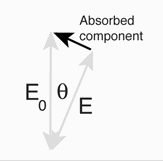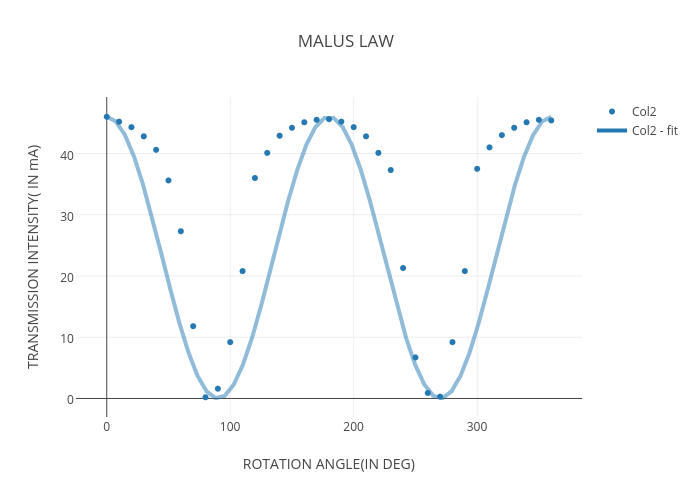If a wave is plane polarised, all the oscillation directions of the electric or magnetic field vector (it’s important in an exam to actually say what’s oscillating) except one are absorbed. This can only happen with transverse oscillations since these are oscillations at right angles to the direction of travel and there are lots of ways for (example) an EM wave can oscillate perpendicular to the travel direction; in a longitudinal wave, there’s only one.
This flash animation shows a polarised EM wave, the electric field is restricted to one direction.
This shows what happens when a polariser is placed in the path of an unpolarised wave. The direction of oscillation is restricted to one. Another crossed polariser reduces the intensity to zero.
Using 3cm microwaves, we see something like this. The microwaves produced from the klystron are already plane polarised – vertical electric oscillations only. We can direct them towards a metal grid, arranged vertically, as shown.  We might imagine that the polarised waves would pass through the grid, much like a wave on a string would pass through the gaps. Quite the reverse happens- the energy is absorbed by the free electrons in the metal of the grid, setting up a stationary wave in the vertical bars, thus absorbing the energy. When the bars are horizontal, the microwave energy passes through unimpeded.
We might imagine that the polarised waves would pass through the grid, much like a wave on a string would pass through the gaps. Quite the reverse happens- the energy is absorbed by the free electrons in the metal of the grid, setting up a stationary wave in the vertical bars, thus absorbing the energy. When the bars are horizontal, the microwave energy passes through unimpeded.
 Applied stress rotates the plane of polarised light. This image shows what happens when a plastic hook is loaded and viewed through crossed polaroids. This phenomenon, known as photoelasticity was discovered by David Brewster (see later). In summary, the effect is due to the fact that the magnitude of the refractive indices at each point in the material is directly related to stresses experienced by the material at that point.
Applied stress rotates the plane of polarised light. This image shows what happens when a plastic hook is loaded and viewed through crossed polaroids. This phenomenon, known as photoelasticity was discovered by David Brewster (see later). In summary, the effect is due to the fact that the magnitude of the refractive indices at each point in the material is directly related to stresses experienced by the material at that point.
Light reflected from surfaces like a flat road, smooth water or glass is generally horizontally polarized. This horizontally polarized light is blocked by the vertically oriented polarizers in Polaroid sunglass lenses, substantially reducing glare.

At a particular angle, however:
Reminding ourselves that weak reflections accompany refraction, when light is refracted at an interface and the reflected and refracted components are at 90 degrees, the surface acts like a polarizer – reflected component is perfectly polarized one way, refracted is partially polarized the other. This happens at Brewster’s angle.

For a glass/air interface, and using Snell’s Law, Brewster’s Angle is about 56 degrees.

Malus’ Law says that when a perfect polarizer is placed in a polarized beam of light, the intensity, I, of the light that passes through is given by
where I0 is the initial intensity, and θi is the angle between the light’s initial polarization direction and the axis of the polarizer.
A beam of unpolarized light can be thought of as containing a uniform mixture of linear polarizations at all possible angles. Since the average value o 
Put another way, if a polarizing filter is placed at some angle theta to a vertically oriented plane of polarized light, its amplitude E will be reduced by a factor cos theta


and since intensity is amplitude squared, then, as above,  This is known as Malus’ Law.
This is known as Malus’ Law.
It can be determined experimentally quite easily. Taping a piece of Polaroid (oriented so as to pass only the vertical component) over a beam of white light from an overhead projector will polarize the beam. Orient a second Polaroid at the same vertical angle and rotate it, using a calibrated LDR circuit to measure the intensity (seen here as a current), taking measurements at suitable angles, all the way around to 360 degrees.
The graph will look something like this, peaking at 0, 180 and 360 (cos squared=1) and zero at 90 and 270, cos squared =0.

